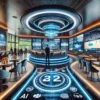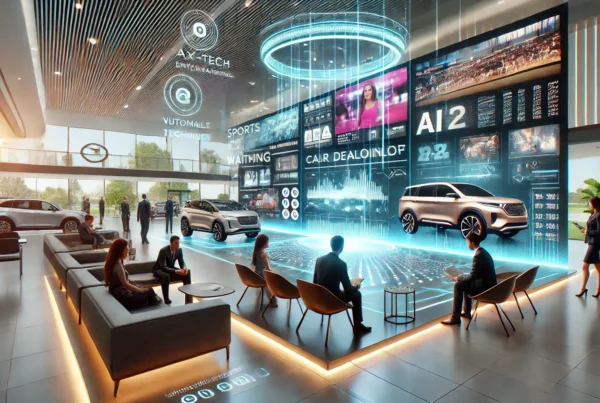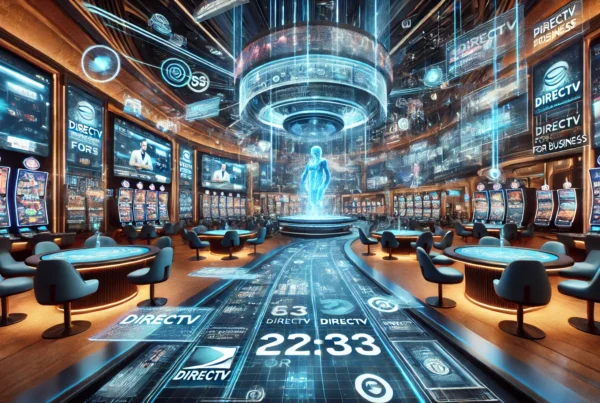Imagine walking into a bustling restaurant, a lively bar, or a sophisticated casino, and being greeted by an array of cutting-edge technologies that transform your entertainment experience. This is not a scene from a futuristic movie but a glimpse into the rapidly evolving landscape of in-premise entertainment. As technology continues to advance at an unprecedented pace, its role in reshaping the future of entertainment within these spaces is becoming increasingly significant.
For business owners and decision-makers in the hospitality, gaming, auto, and private office industries, understanding the impact of technology on in-premise entertainment is crucial. The integration of technologies such as virtual reality (VR), augmented reality (AR), and artificial intelligence (AI) is not merely a trend but a transformative force that enhances customer experiences, drives engagement, and sets businesses apart from their competitors.
At Sports Direct, our mission is to deliver innovative commercial video programming solutions that elevate the entertainment experience in various commercial establishments. We recognize the importance of staying ahead of technological advancements to provide our clients with immersive and personalized entertainment options that cater to their customers’ preferences and expectations.
In this blog post, we will delve into the significant role of technology in shaping the future of in-premise entertainment. We will explore emerging technologies and their impact on the industry, highlighting how businesses can leverage these advancements to create memorable and engaging experiences for their patrons. From the immersive worlds of VR to the interactive possibilities of AR and the personalized touch of AI, we will uncover the potential of these technologies to revolutionize in-premise entertainment.
Join us as we embark on this journey to understand how technology is transforming entertainment spaces and discover how your business can stay ahead in this dynamic landscape. Let’s dive into the future of in-premise entertainment and explore the endless possibilities that lie ahead.
Emerging Technologies Revolutionizing In-Premise Entertainment
The entertainment industry is witnessing a technological revolution, with innovations like virtual reality (VR), augmented reality (AR), and artificial intelligence (AI) leading the charge. These technologies are not only enhancing customer experiences but also providing businesses with new ways to differentiate themselves in a competitive market. This section will delve into the specifics of these technologies and their applications in in-premise entertainment.
For business owners and decision-makers in the hospitality, gaming, auto, and private office industries, understanding the impact of these technologies is crucial. Let’s explore how VR, AR, and AI are revolutionizing in-premise entertainment.
Virtual Reality (VR): Immersive Experiences
Virtual reality (VR) has transcended the realms of gaming and entered the sphere of in-premise entertainment, providing customers with unparalleled immersive experiences. VR installations can transport patrons to different worlds, offering an escape from reality and a compelling reason to return.
For example, Sports Direct has successfully implemented VR in their venues, allowing customers to experience games as if they are right there on the pitch. This technology creates a sense of presence that is unparalleled, making every moment more intense and memorable.
- Enhanced Customer Engagement: VR experiences captivate customers, encouraging longer stays and repeat visits.
- Competitive Edge: Businesses offering VR experiences stand out in the crowded entertainment market.
- Case Study: A renowned casino in Las Vegas saw a 20% increase in foot traffic after introducing VR gaming zones.
Augmented Reality (AR): Enhanced Interactions
Augmented reality (AR) brings a layer of digital enhancement to the real world, allowing customers to interact with their environment in novel ways. Whether it’s through AR games or interactive displays, this technology creates a memorable, shareable experience that can virally promote a business.
For instance, restaurants and bars are leveraging AR to offer interactive menus and entertainment options. Customers can scan QR codes to see 3D models of dishes or play AR games while waiting for their orders.
- Interactive Displays: AR can transform static displays into interactive experiences, engaging customers in new ways.
- Social Media Integration: AR experiences are highly shareable, driving organic promotion through customer-generated content.
- Case Study: A bar in New York City saw a 15% increase in social media mentions after introducing AR-enhanced drink menus.
Artificial Intelligence (AI): Personalized Experiences
Artificial intelligence (AI) is at the forefront of personalization in in-premise entertainment. By analyzing data on user preferences, past behaviors, and even real-time reactions, AI can curate a bespoke experience for each visitor.
For example, Sports Direct leverages AI to suggest events, merchandise, and even food and beverage options that align with individual preferences. This level of personalization fosters a sense of loyalty and encourages repeat visits.
- Data-Driven Insights: AI provides valuable insights into customer behavior, enabling businesses to tailor their offerings effectively.
- Operational Efficiency: AI optimizes various operational aspects, from inventory management to dynamic pricing models.
- Case Study: A leading hospitality chain implemented AI-driven recommendations, resulting in a 25% increase in customer satisfaction scores.
In conclusion, the integration of VR, AR, and AI is not merely a trend but a transformative force that enhances customer experiences, drives engagement, and sets businesses apart from their competitors. By embracing these technologies, businesses can create memorable and engaging experiences for their patrons, ensuring they stay ahead in the dynamic landscape of in-premise entertainment.
Enhancing Customer Engagement Through Interactive Technologies
Interactive technologies are key to creating engaging and memorable in-premise entertainment experiences. From touch screens and kiosks to wearable tech, these innovations allow customers to interact with their environment in new and exciting ways. This section will explore how businesses can leverage these technologies to enhance customer engagement.
In today’s competitive market, businesses in the hospitality, gaming, auto, and private office industries must find innovative ways to captivate their customers. By integrating interactive technologies, they can create unique and personalized experiences that not only attract but also retain customers. Let’s delve into some of the most impactful interactive technologies and their applications.
Interactive Touch Screens and Kiosks
Interactive touch screens and kiosks have revolutionized customer interactions in entertainment spaces. These devices provide a seamless and engaging way for customers to access information, make reservations, and even place orders. For example, many restaurants and bars now use digital menus on touch screens, allowing customers to browse options, see detailed descriptions, and even customize their orders.
Moreover, kiosks can streamline the check-in process at hotels and casinos, reducing wait times and enhancing the overall customer experience. The convenience and efficiency offered by these technologies not only improve customer satisfaction but also free up staff to focus on providing personalized service.
- Enhanced Customer Interaction: Touch screens and kiosks provide an intuitive interface for customers to interact with.
- Operational Efficiency: These technologies reduce the workload on staff, allowing them to focus on more complex tasks.
- Case Study: A leading hotel chain reported a 30% increase in customer satisfaction scores after implementing self-service kiosks for check-in and check-out.
Wearable Technology
Wearable technology is another exciting innovation transforming in-premise entertainment. Devices such as smartwatches and wristbands can enhance customer engagement by providing real-time updates, personalized recommendations, and even facilitating cashless transactions. For instance, theme parks and large event venues often use wearable tech to offer guests a more immersive and convenient experience.
These devices can also collect valuable data on customer preferences and behaviors, enabling businesses to tailor their offerings more effectively. By understanding what customers enjoy and how they interact with their environment, businesses can create more targeted marketing strategies and improve overall customer satisfaction.
- Personalized Experiences: Wearable tech allows for real-time customization of the customer experience.
- Data Collection: These devices provide insights into customer behavior, helping businesses make informed decisions.
- Case Study: A popular theme park saw a 25% increase in visitor engagement after introducing smart wristbands that offered personalized recommendations and facilitated cashless payments.
Augmented Reality (AR) and Virtual Reality (VR)
Augmented Reality (AR) and Virtual Reality (VR) are at the forefront of interactive technologies, offering immersive experiences that captivate customers. AR can enhance physical environments with digital overlays, providing interactive and engaging content. For example, restaurants can use AR to create interactive menus, where customers can see 3D models of dishes and get detailed information about ingredients and preparation methods.
On the other hand, VR offers fully immersive experiences that transport customers to different worlds. This technology is particularly popular in gaming and entertainment venues, where it can create unforgettable experiences. For instance, VR gaming zones in casinos and entertainment centers provide a unique attraction that draws in customers and encourages repeat visits.
- Immersive Experiences: AR and VR create engaging and memorable experiences that captivate customers.
- Innovative Marketing: These technologies offer new ways to promote products and services, driving customer engagement.
- Case Study: A casino in Las Vegas experienced a 20% increase in foot traffic after introducing a VR gaming zone, highlighting the technology’s potential to attract and retain customers.
Operational Efficiency Through Technological Innovations
Technology is not only enhancing customer experiences but also improving operational efficiency for businesses. From automated inventory management to energy-efficient solutions, these innovations help businesses run more smoothly and effectively. This section will explore the various ways technology is streamlining operations in in-premise entertainment.
Improving operational efficiency is crucial for businesses in the hospitality, gaming, auto, and private office industries. By leveraging technological innovations, these businesses can optimize their processes, reduce costs, and enhance overall performance. Let’s delve into the specific technologies that are driving operational efficiency in in-premise entertainment.
Automated Inventory Management
Automated inventory management systems are revolutionizing the way businesses handle stock and supplies. These systems use advanced algorithms and real-time data to monitor inventory levels, predict demand, and automate reordering processes. This not only reduces the risk of stockouts and overstocking but also minimizes manual labor and errors.
For example, a leading restaurant chain implemented an automated inventory management system that reduced their inventory holding costs by 15% and improved order accuracy by 20%. By integrating this technology, businesses can ensure they always have the right products at the right time, enhancing operational efficiency and customer satisfaction.
- Real-Time Monitoring: Automated systems provide real-time insights into inventory levels, enabling proactive management.
- Cost Reduction: By optimizing inventory levels, businesses can reduce holding costs and minimize waste.
- Case Study: A casino in Las Vegas saw a 25% reduction in inventory costs after implementing an automated system.
Energy-Efficient Solutions
Energy-efficient technologies are becoming increasingly important for businesses looking to reduce their environmental impact and operational costs. From LED lighting to smart climate control systems, these solutions help businesses save energy and money while maintaining a comfortable environment for customers.
For instance, a hotel chain that adopted energy-efficient lighting and HVAC systems reported a 30% reduction in energy consumption, resulting in significant cost savings. These technologies not only contribute to sustainability efforts but also enhance the overall efficiency of operations.
- LED Lighting: LED lights consume less energy and have a longer lifespan compared to traditional lighting.
- Smart Climate Control: Automated climate control systems adjust temperature settings based on occupancy and weather conditions, optimizing energy use.
- Case Study: A large entertainment venue reduced its energy costs by 20% after installing smart climate control systems.
Advanced Security and Surveillance
Modern security and surveillance technologies are essential for ensuring the safety of customers and staff while protecting business assets. Innovations such as facial recognition, AI-powered surveillance, and advanced access control systems enhance security measures and streamline operations.
For example, a major casino implemented AI-powered surveillance cameras that reduced security incidents by 40% and improved response times. These technologies provide real-time monitoring and analytics, enabling businesses to detect and address potential threats more effectively.
- Facial Recognition: Advanced facial recognition systems enhance security by identifying individuals in real-time.
- AI-Powered Surveillance: AI-driven cameras and software analyze footage to detect suspicious activities and alert security personnel.
- Case Study: A high-end hotel improved its security measures and reduced theft incidents by 35% after adopting advanced surveillance technologies.
Embracing Technology for a Future-Ready Entertainment Experience
As we journey through the transformative landscape of in-premise entertainment, it’s clear that technology is the cornerstone of future success. The integration of advanced technologies like VR, AR, and AI is revolutionizing how businesses engage with customers, offering immersive and personalized experiences that were previously unimaginable.
Businesses that embrace these innovations will not only enhance their customer engagement but also streamline their operations, ensuring they remain competitive in an ever-evolving market. Here are some key takeaways:
- Virtual Reality (VR) provides immersive experiences that captivate customers and encourage repeat visits.
- Augmented Reality (AR) transforms static environments into interactive and engaging spaces, driving organic promotion through shareable moments.
- Artificial Intelligence (AI) offers personalized experiences and operational efficiencies, from tailored recommendations to dynamic pricing models.
- Interactive Technologies like touch screens and wearable tech enhance customer engagement and streamline operations.
By staying ahead of technological trends, businesses can create memorable, personalized, and engaging environments that attract and retain customers. The role of technology in the future of in-premise entertainment is not just about keeping pace with competitors but about setting new standards for customer experiences.
We encourage businesses to explore these technologies and consider how they can be integrated into their operations. By doing so, they can ensure they are not only meeting but exceeding customer expectations. Ready to transform your entertainment space? Visit Sports Direct to explore innovative solutions tailored to your industry.








